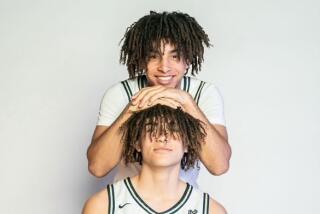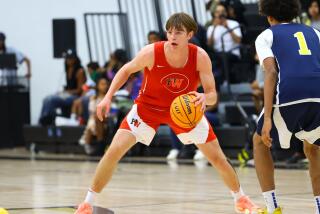WCAC SHOWDOWN: LOYOLA VS. PEPPERDINE : GONDO AS IN HONDO : Gondrezick Gives Waves Sixth Man and Balance-Plus
- Share via
Pepperdine Coach Jim Harrick believes in sharing the ball and in balanced scoring. With everyone scoring, Harrick’s Waves, who seldom include many of the nation’s most-sought recruits, have gone to the NCAA tournament three of the last four seasons.
When Pepperdine won the West Coast Athletic Conference championship a year ago, the starters had double-figure scoring averages. The starters are all back this season, and each is getting his points, although a couple of their averages have dipped slightly.
The lower averages, however, are no indication of a team letdown. Rather, Harrick’s current squad strongly resembles some checking accounts. It has balance-plus.
The plus is sixth man Grant Gondrezick, 23, who has returned to the lineup after sitting out last season because of a knee injury. Gondrezick, a 6-5 fifth-year senior who fills in at every position, is averaging 12.7 points while playing about 22 minutes a game.
Said Harrick: “Gondrezick has taken time, points and statistics away from our starters. But he’s made us a better team.”
The Waves, ranked 19th nationally in the United Press International coaches’ poll, are 19-4 overall and 7-1 in the WCAC going into tonight’s game with conference leader Loyola Marymount at Loyola’s Gersten Pavilion.
John Havlicek, the Ohio State All-American who achieved NBA stardom with the Boston Celtics, was basketball’s definitive sixth man. He switched from guard to forward with ease and excelled at both positions.
Gondrezick, of course, is not in Havlicek’s class, but Havlicek, known as Hondo, did not play center often. Certainly not as often as Gondrezick does. Gondrezick is needed everywhere on many nights--to spell a tiring starter or fill in when someone is not having a good game.
Scoring is not all that he does. He rebounds well against players who tower over him. Although his bad knee has hampered his lateral movement, he still plays good defense because he is experienced and anticipates the moves of opponents.
And he has no peer when it comes to scrambling for loose balls. Daring is too timid a term for Gondrezick.
Harrick said: “He’s so smart and has been playing for me so long that he can visualize where everybody’s going to be. He takes a charge. He goes for loose balls. And did you ever notice how many times he get his hands on the ball? He’s always around the ball, and that indicates to me that he’s a good player.”
Gondrezick could be a key figure against Loyola tonight, Harrick said. “They play mostly a zone defense, and he’s a good zone breaker. Plus he matches up with them pretty decently.”
In May of 1984, Gondrezick must have questioned whether he would ever match up against anyone. He had just undergone major surgery on his left knee, and he must have wondered at times if he had overdrawn his basketball account, tapped out as a player.
The knee had been injured in the summer of 1979, just before his freshman season at Pepperdine. While he was working on a construction job, a 200-pound slab of steel fell and hit his knee, cracking the bone.
Though he had arthroscopic surgery to repair some of the damage, he was told that he would eventually have to have a more extensive operation. But he played three seasons with the injury.
He was mostly a bench warmer as a freshman, but in his sophomore year he was the first guard off the bench and the following year he led the Waves in scoring with a 13.7-point average. But he was playing in pain.
He had contemplated having more surgery and sitting out his junior year of 1983-84. But he said that he decided to play--and he played well--despite the fact that a remaining bone fragment kept scraping his kneecap and he had great difficulty moving laterally.
Harrick said that Gondrezick had “the worst looking knee I’ve seen (that had) no cartilage or ligament damage.”
After the second surgery, Gondrezick said that he was in a cast from hip to ankle for four months, three of them on crutches. “It was the worst time of my life,” he said. “It was during the summer heat, and the pain made it hard to sleep.”
Not playing at all last season was probably harder on him. He had to sweat through rehabilitative exercises and other therapy while his teammates were out there winning.
His brother Glenn, a former Nevada Las Vegas basketball star who played two years with the New York Knicks and four years with the Denver Nuggets, said that doctors told Grant after the second operation that “he’d be lucky if he was able to walk again properly.”
Glenn, now 30, and a real estate salesman in the Denver area, said that the doctor’s bad news was good news for his brother. “I knew that would give him that much more motivation to come back.”
Grant is the fourth in a line of five brothers who have played basketball beyond high school. Gordy, 31, played at Rangely Junior College in Colorado, Glenn at Nevada Las Vegas and in the pros, George Jr. at Colorado State, Grant at Pepperdine and 19-year-old Gale, the youngest, is a sophomore guard at Utah.
Grant hopes to parlay his athletic ability and determination into a spot with a professional team, preferably in the National Basketball Assn.
Harrick said that professional scouts have shown interest in three of his players: Gondrezick, Dwayne Polee and Anthony Frederick.
“I think they like Polee for his defensive ability,” he said. “They like Frederick for his all-around athletic ability, his versatility and his ability to play big-time defense. They like Grant for his athletic ability, his size and strength and his ability to shoot the ball.”
Glenn Gondrezick, who played for two years in Italy and another in Austria after he left the NBA, said that Doug Moe, coach of the Denver Nuggets, has talked to him about Grant. “But I stay out of it unless I’m asked,” he said. “If I said he’s a first-round draft pick and it doesn’t pan out, it doesn’t make Grant look good, nor me.
“But I think he’s a pro player, or could be. He’ll outwork anybody at it and do whatever he needs to get it done. He could help somebody a little bit in spots, and by the second year I think he’d be a key member of some team.”
He’s a key member of Pepperdine’s team now, and he thinks his pro prospects would be enhanced if the Waves reach the NCAA tournament and do well in it. “But I’m not a superstar,” he said. “I’m only as good as the team is.”
BALANCED ATTACK
Pepperdine had all five of its starters average double figures in scoring last season en route to a 23-9 overall record and the WCAC championship. Here are the field-goal percentages and scoring averages for those players last season and the Waves’ balance sheet for their top six players this season:
1984-85 1985-86 FG% AVG PLAYER FG% AVG .503 11.8 ANTHONY FREDERICK .576 10.0 DNP DNP GRANT GONDREZICK .551 12.7 .540 12.2 JON KORFAS .497 9.0 .535 10.3 LEVY MIDDLEBROOKS .491 8.4 .472 15.7 DWAYNE POLEE .530 15.0 .546 15.9 ERIC WHITE .557 15.2
More to Read
Get our high school sports newsletter
Prep Rally is devoted to the SoCal high school sports experience, bringing you scores, stories and a behind-the-scenes look at what makes prep sports so popular.
You may occasionally receive promotional content from the Los Angeles Times.






